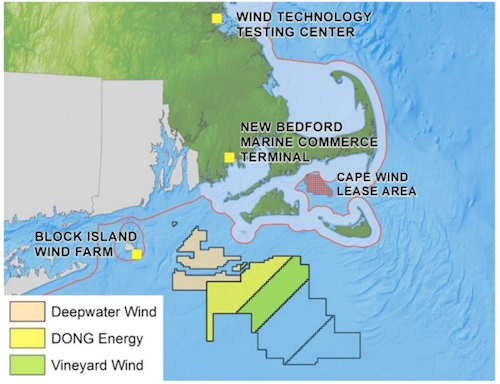Massachusetts’ demand for non-fossil-fuel sources of electricity is driving proposals to bring Quebec electricity down through NH, and it’s getting closer to producing the nation’s first offshore wind farm of real size. (Block Island in Rhode Island waters is dinky.)
State law mandates 1,600 MW in offshore wind (that’s about one and a half Seabrooks’ of output) – and June could see the first step toward getting companies to bid on building at least 200 MW of that, reports Renewable Energy World.
The article includes the above map, which shows what Cape Wind did wrong: Too close to rich people.


 Return to the Concord Monitor
Return to the Concord Monitor
1600 MW is not one and a half of Seabrook’s output. You are once again conflating installed capacity with output. Total output is energy produced, which is capacity factor times capacity times time (typically a year). Nuclear plants run at about 90% or more capacity factor, which makes them prodigious producers of electricity. Offshore wind might get 35 or 40% capacity factor, in non-dispatchable form (which means you may or may not have it when you need it).
But even if you get that, why use it to displace nuclear, which is a clean energy source? Your quoting of Seabrook capacity implies that you’d rather use wind generation to knock nuclear out of the lineup when in fact there are better candidates for displacement, things like biomass, coal, petroleum, and natural gas, all of which are hundreds of times more polluting on a CO2-equilavent basis than nuclear.
You read “output” to mean “output over a long period of time” and I see it meaning “output at any given moment”. I am aware of the different between nameplate capacity and production over time.
I am not saying wind is better or worse than nuclear, or either should displace the other. I have long used Seabrook as a unit of comparative measure to give laymen some idea of what MW numbers mean – it’s like the classic “X is as heavy as 7 elephants” line.
OK, you correctly called me on imputing intent. I have seen so many articles that use the focus group-tested phrase “such-and-such is equivalent to x number of nuclear plants”, with the less-than-subtle implication that such-and-such is better than nuclear, when in fact it would be MUCH better to keep the nuclear and retire things like coal or oil or natural gas.
Offshore wind has marginally better capacity factor than onshore, but that is partially offset by higher construction and maintenance costs. Servicing a multi-ton generator hoisted 400 feet into the air, such as you have now with the latest design of a HAWT in the MW range, on a floating platform is a different breed of challenge than backing up a crane on land to service a similar installation. But the crucial Achilles’ Heel remains the relatively low capacity factor and the non-dispatchable nature of intermittent sources. Nobody has demonstrated an economical form of utility-scale storage, and even if there were one there are limits to storage. A compact, high-density energy source that provides dispatchable energy is still hard to beat for reliable grid operation.
That’s not hard to beat – it’s *impossible* to beat for reliable grid operation. Fossil fuel and nuclear power are awesomely wonderful and no renewable will ever touch them in terms of being dispatchable sources of energy.
If it wasn’t for all that pollution stuff, which is a huge cost on all of society even if we are slow to attach the dollar signs, then we’d be fools not to stick with them.
But that pollution stuff is real, so we’d be fools to stick with them. Time to reshape the grid so it can be reliable without having to destroy everything around us.
I agree with your assessment of the pollution effects of fossil fuel use. No one has ever demonstrated the ability for large-scale sequestration of CO2 emissions from even the most efficient natural gas-fired plants. Likewise, sulfur removal using lime-limestone wet scrubbers for coal-fired generation simply trades one form of pollution (airborne emissions) for another (sludge ponds). The volume of such material alone makes it a formidable challenge.
Nuclear waste management also presents challenges but IMO those can be overcome using available technology. Probably the best initial steps along those lines would be to amend the NWPA to focus more on volume reduction by partitioning and actinide recycle and redirect geologic disposal from Yucca Mountain to the salt formations in NM and west TX. The volume will be so much smaller than simply dumping used fuel, and the heat load will be essentially eliminated. On the front end, supplement LWR technology with MSR or LMBR systems to improve fuel economy and also take advantage of passive safety features, like the IFR was to demonstrate for LMRs before politics killed it in the 1990s.